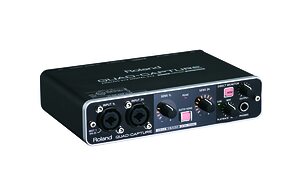Roland have just announced the first new synth to bear their legendary Jupiter name since 1983. The Jupiter 80, as the newcomer is known, is being touted by Roland as an homage to their revered Jupiter 8 analogue synth, which was launched in 1981.
At first glance, the family resemblance is indeed striking: it has a similar colour scheme to its esteemed forebear, including the multi‑coloured buttons that run above the keyboard, and the orange markings that distinguish the different control sections. Inside, however, it would seem to be a very different beast. For starters, its sounds are generated digitally, unlike the Jupiters of yore. It also doubles the Jupiter 8’s multitimbrality, to four parts, though it does offer a similar split‑keyboard arrangement to the original — the keys are split into sections labelled Upper, Lower and Solo, with the fourth timbre coming courtesy of a pe rcussion engine.
rcussion engine.
Pride of place on the Jupiter 80’s top panel is given to a large, colour touchscreen. Other hands‑on control elements include four sliders, four rotary encoders, a pitch‑bend/modulation joystick, and Roland’s D‑Beam optical controller.
As you’d expect, the Jupiter 80 features analogue modelling synthesis, and it also has a conventional digital synth engine for creating more ‘modern’ sounds. In addition to these two generators, it can also produce sounds using what Roland call the SuperNatural engine. This uses physical modelling techniques to produce acoustic instrument timbres, including pianos, brass instruments, strings and more. According to Roland, the engine “constantly analyses the player’s natural keyboard performance” to create convincing sounds and articulations.
Roland say that they set out to create “the most expressive synthesizer possible”, with the SuperNatural sounds in the Jupiter 80 apparently providing “the most authentic acoustic playing experience for live performances and studio recordings”.
More info about the Jupiter 80 should be available on the Roland web site, and we’ll be putting it through its paces in an exclusive SOS review soon!
Other Musikmesse revelations from Roland include a new audio interface and a portable recorder. The interface is dubbed the Roland Quad-Capture, and it is a USB device. As the name suggests, it provides computers with four‑in/four‑out audio connectivity, in the form of two front‑panel ‘combi’ jack/XLR sockets (both of which can handle mic or line signals, and one of which will accept instrument‑level sources), S/PDIF two digital inputs, two digital outputs, and two line outs, which are mirrored on the front‑panel headphone socket.
Direct monitoring can be achieved via a Mix control, which blends the signals being recorded with a stereo output from your computer. If you’re recording mono inputs, a front‑panel switch sums these to mono in the monitor path, avoiding the disconcerting sensation of hearing your vocal and guitar hard‑panned in the foldback mix.
The two preamps on the Quad‑Capture are digitally controlled, and are apparently exactly the same design as can be found in the high‑end V-Studio 700 controller and M400 digital console. They are equipped with an ‘Auto Sens’ function, accessed via a button on the front panel, which automatically sets the preamps’ gain levels based on their input signals.
The Quad‑Capture is compatible with both Windows 7 and Mac OS 10.6 (support for older operating systems isn’t mentioned). Usefully, it gets its power from USB, eliminating the need for a separate power supply.
Finally, Roland subsidiary Boss have announced an update to their popular portable multitrack recorder, the Micro BR. The new model, known as the Micro BR80, takes the original’s concept and doubles the playback track count to eight, while also increasing the number of ‘virtual’ tracks to 64, allowing you to perform advanced edits and comps. It also features a new Live Record mode, which turns it into a simple stereo recorder. The new model has been fitted with a pair of condenser mics (the original had only one built‑in microphone), and it can also accept external mic, instrument and line‑level sources.
The Micro BR80 has been generously equipped with onboard processing capabilities. Guitar and bass amp‑modelling and effects come from a COSM (Composite Object Sound Modelling) engine, while the recorder’s built‑in vocal treatments are apparently derived from Boss’ VE20 Vocal Performer pedal. There’s even a selection of mastering effects included, for giving your mixes that extra bit of polish. Roland say that while the effects are easy to instantiate and tweak, more advanced users will be rewarded with an extensive set of menu‑adjustable parameters and settings.
Backing tracks and rhythm patterns are provided, in a range of different genres, and a number of practice‑friendly features have also been incorporated, such as independently adjustable playback speed and pitch, an AB Repeat function (which loops parts of songs for practice purposes), and the ability to import your own WAV and MP3 files to jam along to.
As if all that wasn’t enough, the Micro BR80 also features a USB socket, which, as well as facilitating file transfer, turns the recorder into an audio interface! The BR80 ships with a copy of the Sonar X1 LE DAW software, as well as file‑management and audio‑conversion software.
For more information about these new Roland goodies, check out the company’s web site, below.
